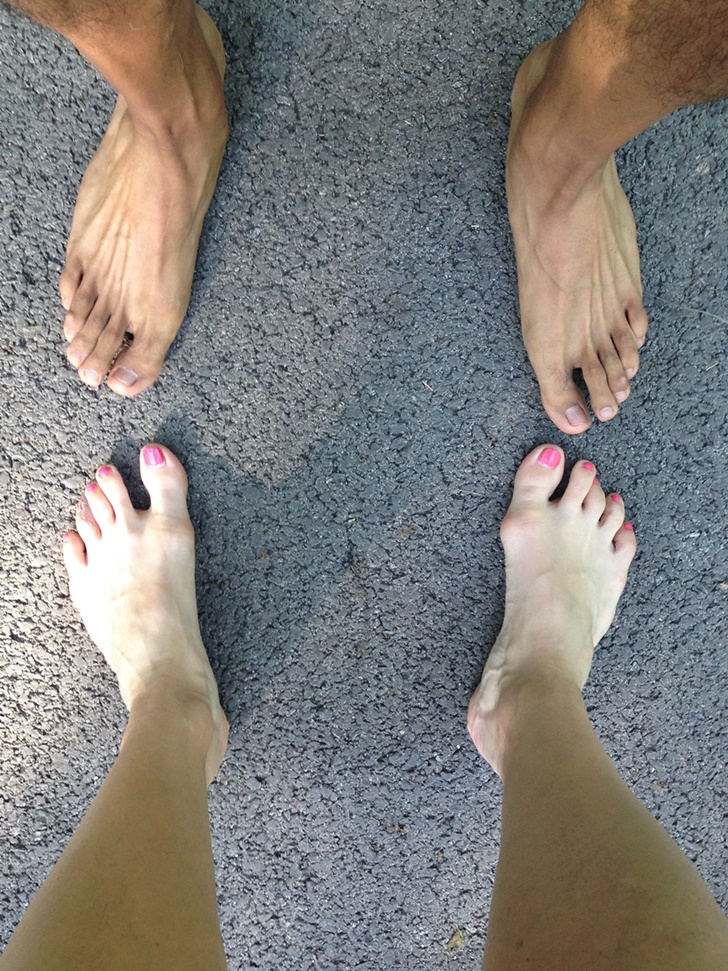Runners transitioning to forefoot running from heel strike running may experience top of foot pain after running, and this pain could be a muscular edema of the foot and ankle.
What is an edema and how does it develop during running?

Top of Foot Pain After Running
An edema is localized swelling that occurs on parts of the body that is confronted with high mechanical demands –the foot and ankle is a great place for an edema swelling to develop.
The edema swelling is due to abnormal accumulation of fluid in the soft tissues. But running-related edemas of the foot and ankle haven’t been reported as a bad thing, an edema is just a sign of adaptation and development of stronger soft and connective tissues.
If you are learning a new running style, such as forefoot running, you now activate muscles that have been essentially under-active.
- In the context of transitioning to forefoot running, an edema is the byproduct of a natural physiological response of osseous remodeling due to newly added stress and is considered essential for normal development and maintenance of bone health.

During the transition to forefoot running, the common areas for an edema to occur is on the top of the foot or on the outside of the ankle.
An edema on the top of the foot is often due to high bending moments on the metatarsals from aggressive push-off during forefoot running. It is becoming more excepted that habitual forefoot and barefoot runners do not push-off with their foot, but rather pull the foot up from the ground.
An edema on the ankle is due to greater demands on the ankle plantarflexor muscle tendon units.
The demands of the ankle are different in forefoot running than in heel strike running, thus an ankle edema during transition reflects the adaptation to a new running condition.
If learned properly, the transition to forefoot running, shod or barefoot, provides the appropriate application of stress for remodeling to occur, resulting in increased bone strength.
However, the severity of the edema hinges on the amount of training volume and/or the learners comprehension of the proper forefoot running style.
- If you run too much and do so with the wrong technique, the severity of the edema will be high.
Like anything else, if performed incorrectly and/or if regular training volume is maintained during the transition to forefoot running, bone fatigue and fracture may occur because bone remodeling cannot keep up with continued stress under these circumstances. This is why scaling back your training volume is imperative to avoiding injury during your transition.
So, in the case of learning the proper forefoot running technique, any pain, in the form of an edema, experienced during this time is essentially weakness leaving the body.
More on Forefoot Running:
- How Forefoot Running Prevents Injury
- Examples of Forefoot Running Shoes
- Best Pre-Run Fuel
- Pose Running Works
- Xero Shoes
References:
Anderson, MW and Greenspan, A. Stress factors. Radiology, 1996; 199(1):1-12.
Dominik et al. Ankle plantarflexion strength in the rearfoot and forefoot runners: a novel clusteranalytic approach. Human Mov Sci, 2004; 35:104–120.
Ridge et al. Foot bone marrow edema after a 10 week transition to minimalist running shoes. Med Sci Sports Exer, 2013; 45(7):1363-8.
Bretta Riches
BSc Neurobiology; MSc Biomechanics candidate, ultra minimalist runner & founder of RunForefoot. I was a heel striker, always injured. I was inspired by the great Tirunesh Dibaba to try forefoot running. Now, I'm injury free. This is why I launched Run Forefoot, to advocate the health & performance benefits of forefoot running and to raise awareness on the dangers of heel striking, because the world needs to know.
Latest posts by Bretta Riches (see all)
- Does Foot Strike Really Matter in Running? YES! - 17/04/2024
- Heel Lifts Increase Injury in Runners - 16/04/2024
- Are Minimalist Shoes Good for Seniors? YES! - 14/04/2024

Leave a Reply